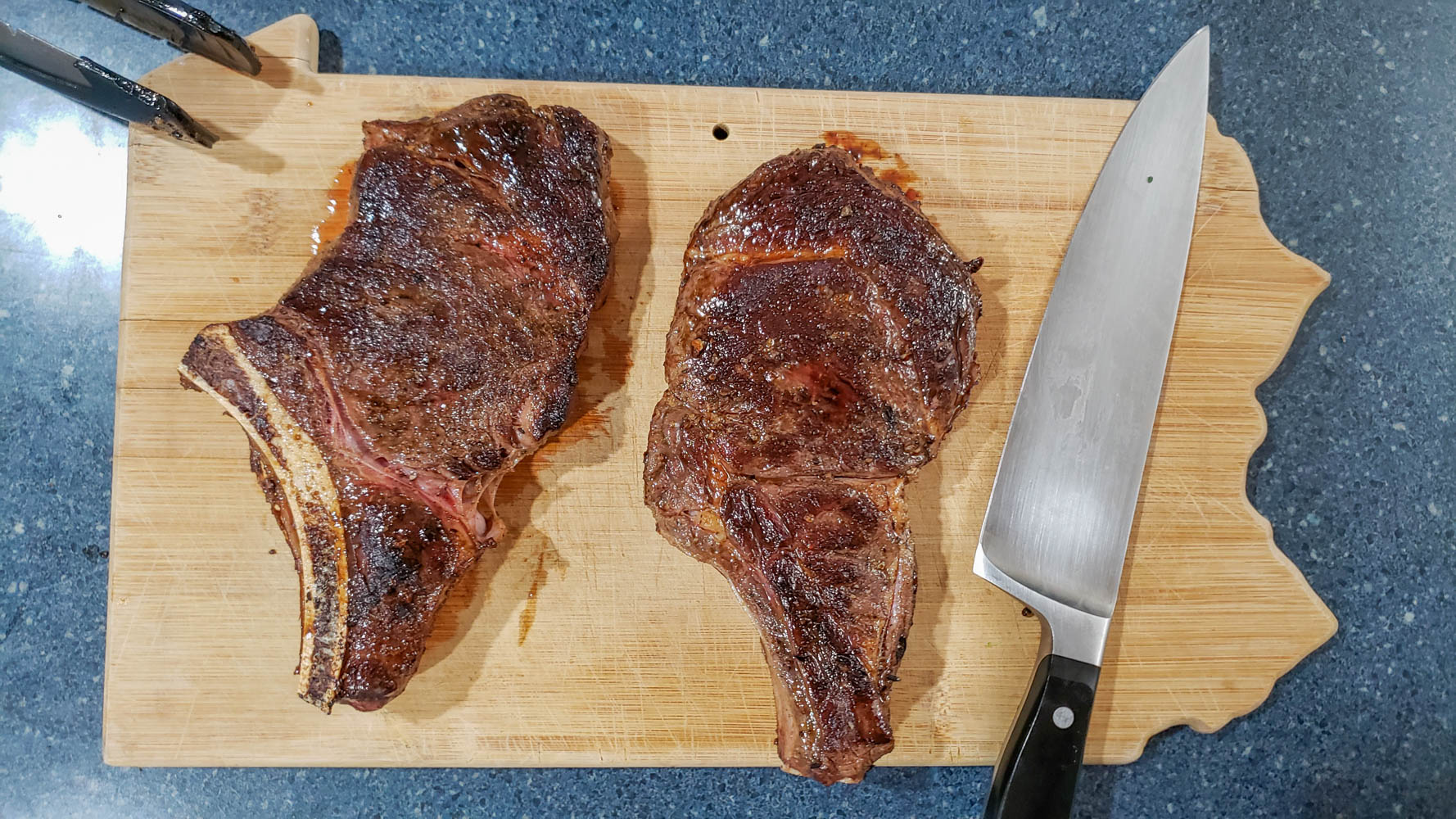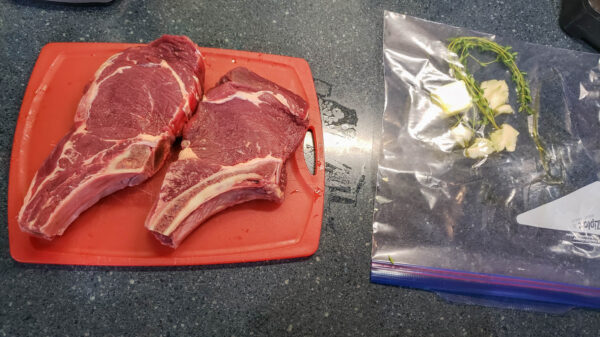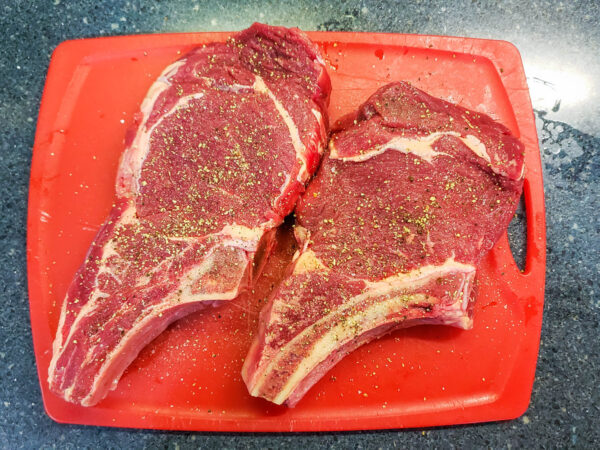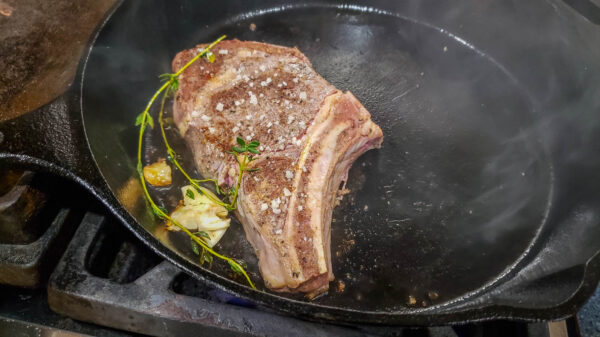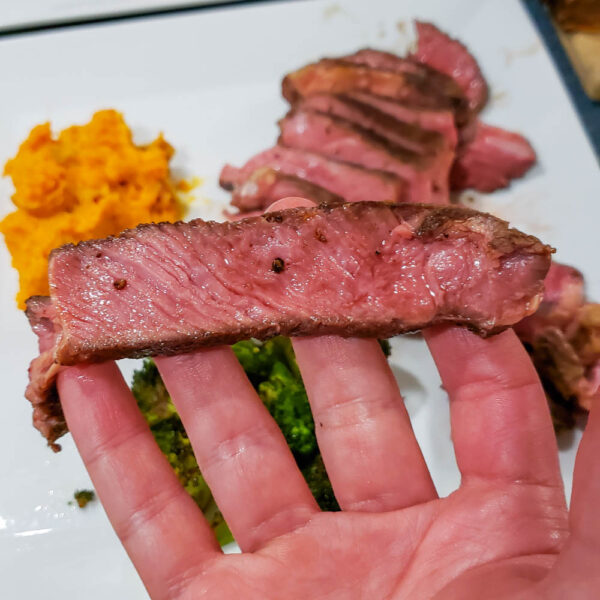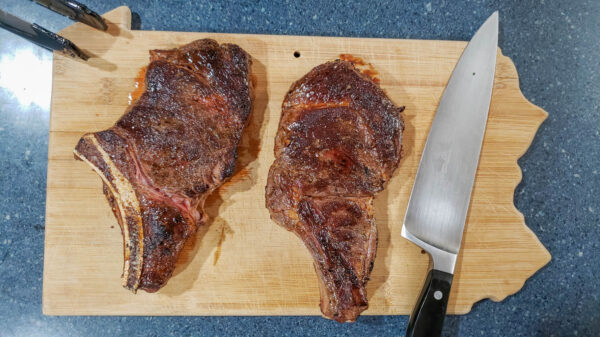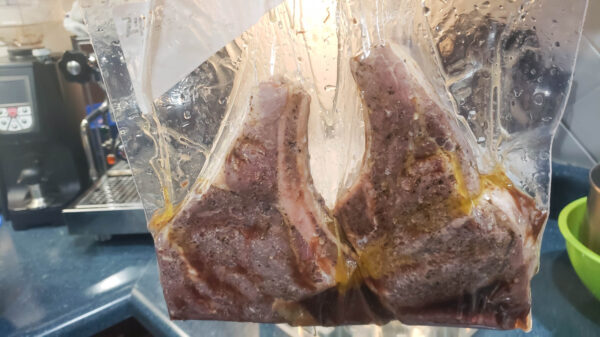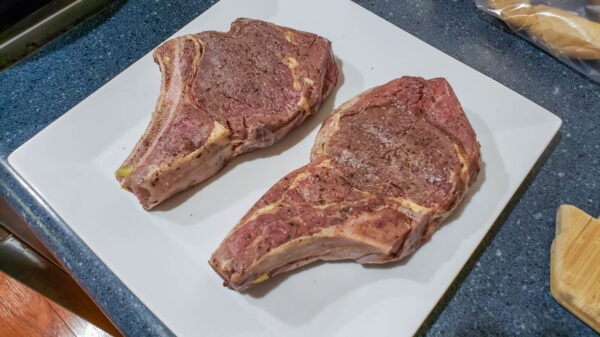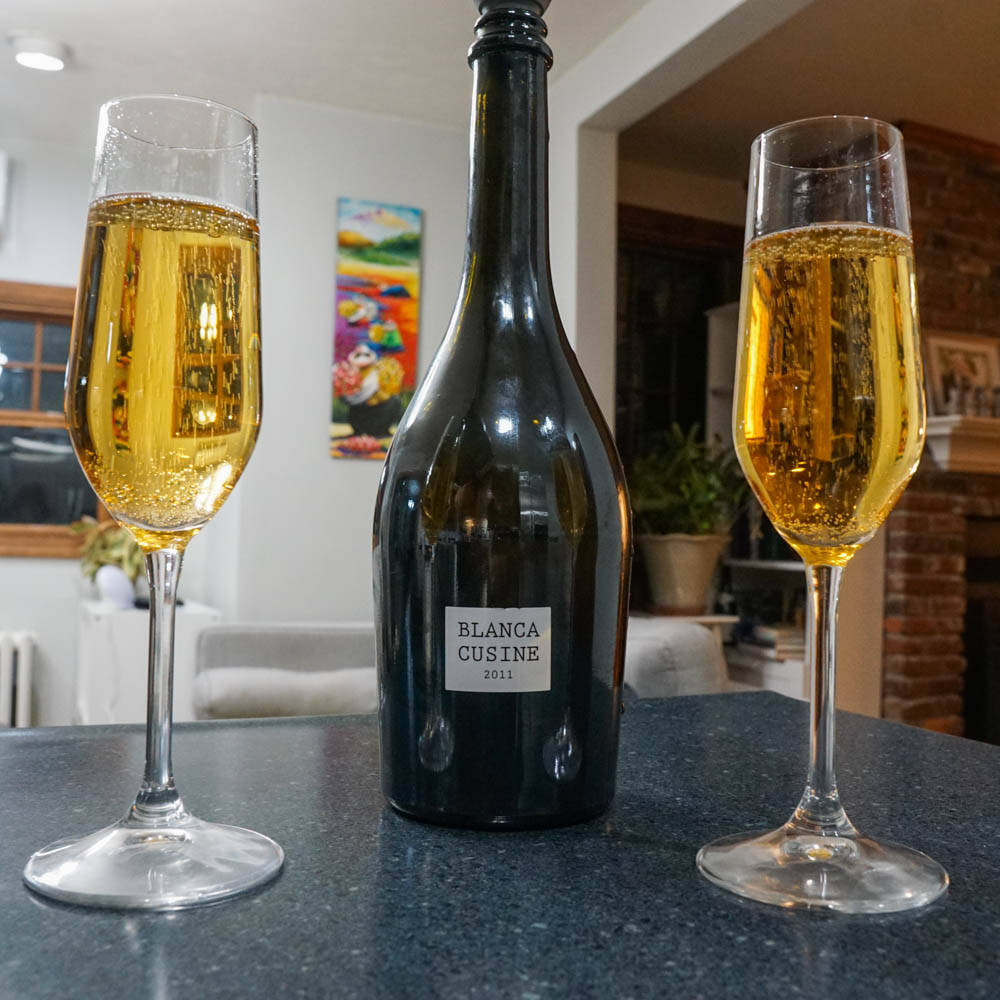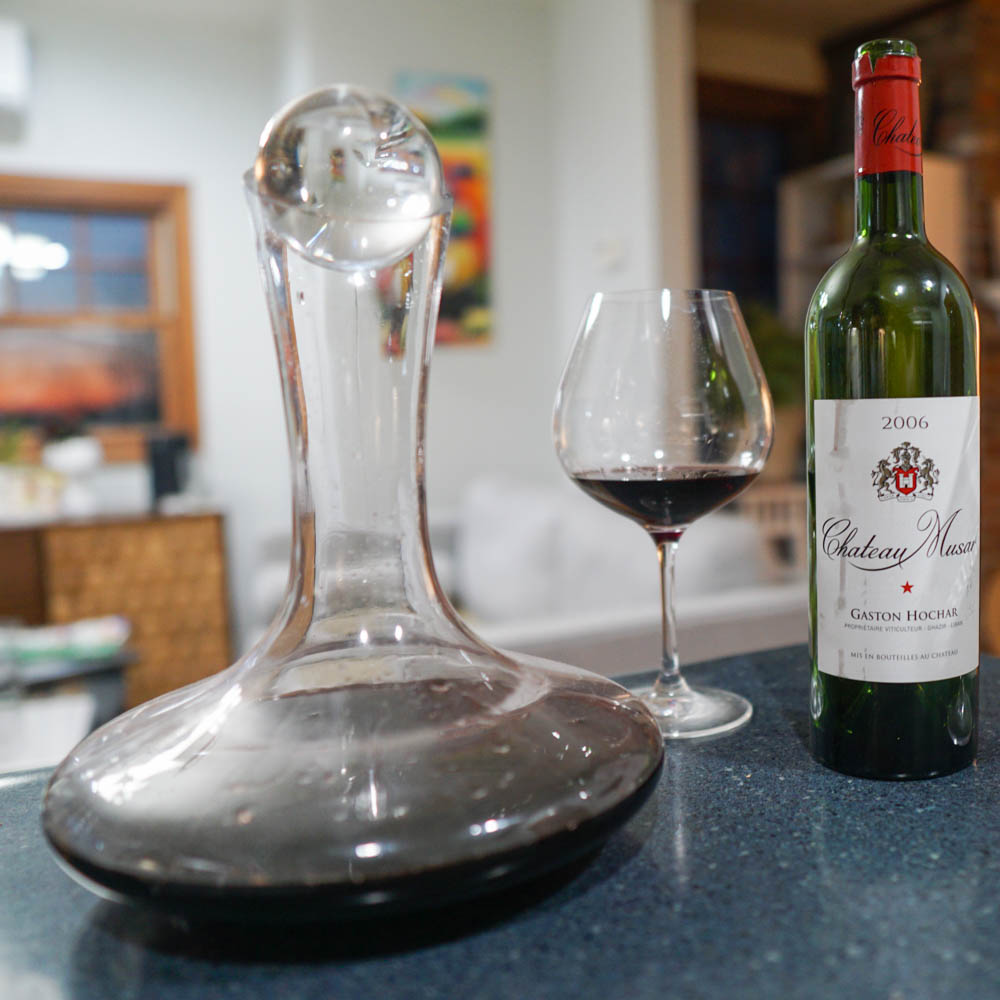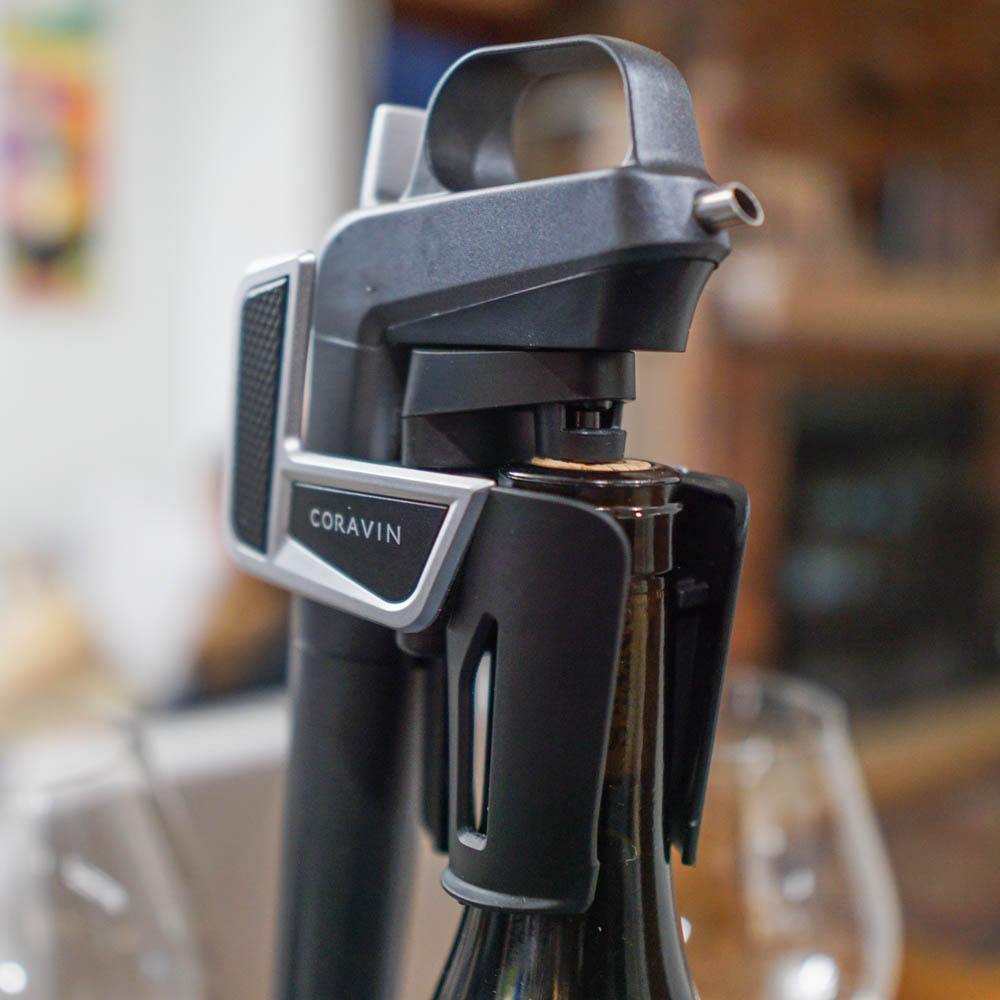Published by Jeremy.
Disclaimers: We use demographic data, email opt-ins, display advertising, and affiliate links to operate this site. Please review our Terms and Conditions for more information. This website is intended for those of legal drinking age in your jurisdiction.
When reading wine websites and blogs, we can find an untold number of food and wine pairing recommendations. One of our favorite books, What to Drink With What You Eat, is a literal tome on this single topic (and is one of our most-referenced books- truly a must-own).
Our blog is no different in this respect as we include comments on the foods we pair with our wine in almost every review.
What we do not regularly see is how to cook said food to pair with your wine. That part is often left to your own devices to figure out. So we thought it would be fun to periodically share some of our own recipes for popular food and wine pairings to help get you part of the way there for an epic dinner!
First up? Steak. But not just any steak- the perfect sous vide steak served medium-rare.
Note: When it comes to cooking steaks, we don't like to speak definitively in cooking terms. There are many variables that come into play to get the perfect sear, internal temperature, and the like. As such, the cook times in this are starting guidelines. You may need to tweak some aspects of the recipe here or there for your own personal tastes, steaks (cut and thickness), and so on. But unlike cooking on a grill, you'll get to a perfect steak quickly with a sous vide!
Ingredients and Tools Needed for a Sous Vide Steak
To prepare this recipe, you'll need the following items:
- Sous Vide
- Water Bath Vessel with Lid
- Cast Iron Skillet
- Instant Read Thermometer
- Gallon-sized Freezer Bags or Vaccum Bags
- A Medium-to-Large Bowl for an Ice Bath
- Tongs, Oven Mitts, and a Timer
- 1″ Thick Rib Steaks (or your favorite)*
- Butter
- Aromatics (Rosemary, Thyme, and Garlic are all good)
- Kosher Salt, Coarse Sea Salt, and Pepper
*Our personal favorite cut is rib steak. It often has the best marbling and is, in our opinion, is one of the most flavorful cuts of steak out there. You can follow this cooking process with just about any steak you like, but we recommend cuts to be a minimum of 1″ thick to fully enjoy the full potential of cooking with a sous vide. We discuss why that is at the end of this article.
Why Cook Sous Vide Style?
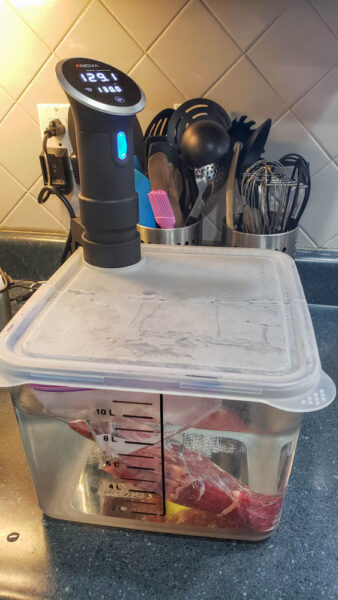
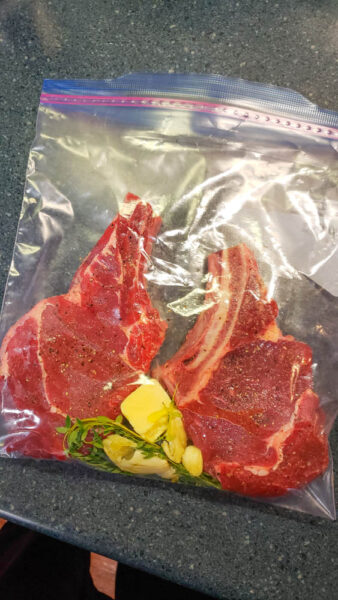
We love cooking with our sous video because it lets us have 100% perfect application of heat into our food. Want your steak cooked medium-rare (130 degress Fahrenheit internal temperature)? Set your sous vide to 130 and sit back while it does all the work for you. Want to go a bit warmer? You can kick it up a few degrees. Cooler? You also can reduce it a few degrees. The water temperature remains constant during cooking and you can ensure your food will always reach the exact temperature you want it to.
We've used ours to cook steaks, make chicken tikka masala, cook pot de creme desserts, make bitters for cocktails, and more. We consider it one of the essential tools in our cooking arsenal. (Even better, most recipes are set it and forget it like a crockpot- just much better temperature control!)
For steak, the one thing it does not do is sear the outside. Since we love the flavors that the Maillard reaction provides when cooking steaks on a cast iron or over an open flame, we do a two-part process for our steaks- first cooking in sous vide and finishing with a sear on the cast iron.
How to Make a Perfect Sous Vide Steak
To cook the perfect sous vide steak medium rare, we will use the following steps. This is broken up into sous vide and cast-iron sections respectively.
Please note that we do not place more than two steaks in any given freezer bag. If you would like to cook more steaks, split them up into multiple bags with butter and aromatics in each. More steaks could work in a single bag as long as they are not overlapping at all.
- If your steaks are wet when removing them from the packaging, pat both sides dry with a paper towel.
- Season both sides of your steaks generously with cracked salt and pepper.
- Put a tablespoon of butter and any aromatics into a gallon-sized freezer bag or vacuum bag.
- We generally put 1-2 sprigs of thyme and/or rosemary, and two cloves of crushed garlic per bag.
- Place no more than two steaks in a single freezer or vacuum bag. Orient these side by side with the aromatics in between them. Do not stack the steaks.
- If using a vacuum bag, seal it up using the vacuum tool you have available. If using a zip lock bag, use the water displacement method to remove the air from the bag as you insert it into the water bath.
- If your steaks begin to float to the surface, you may need to weigh them down somehow. We sometimes put a wooden spoon on the bag to help keep it submerged. Likewise, we always keep the zipper portion of the bags above the water line out of an abundance of caution.
- Set an alarm for 2-3 hours- shorter for thinner steaks (sub 1″) and longer for thicker steaks (greater than 1″) or those with a bone. If your steak is around 1″ exactly, we'll generally let ours go for 2 1/2 hours.
- Per most safety guidelines, it is not recommended to keep meat below 130-140 degrees for longer than 4 hours. So while you could cook longer, we err on the side of caution here.
- When your final time has elapsed, put ice and water in your bowl and transfer the steaks to the ice bath for a minimum of 15 minutes. The only goal of this step is to bring the steaks down to below room temperature to give them an extra few moments of cooking time on the cast iron. Longer time in the ice bath is fine, but you may have to make up for it with a bit longer time on the cast iron later (more Maillard!).
When you're ready to cook, we'll then move on to the cast-iron steps.
- Place a cast-iron over your burner on high heat without any extra oil. We want this so hot that it is starting to smoke.
- When cooking, you may set your smoke detector off- we do regularly when searing our steaks indoors.
- While the cast iron is heating, remove your steaks from the water bath and the cooking bag. Ensure that no residual aromatics are on the steaks too.
- Pat the steaks dry with a paper towel and lightly sprinkle with coarse sea salt on both sides.
- We like to add extra salt at this step as we generally think a fair bit of the original salt is lost in the liquid that renders out. You may also opt to not salt before going into the sous vide and only salt at this stage, but we like a bit of both.
- Prepare a plate of butter and aromatics to the side- roughly one tablespoon of butter, one sprig of thyme or rosemary, and one crushed garlic per steak.
- When the cast iron is smoking hot, place a single steak on one side of the cast iron (not dead center) and push lightly on it with tongs to ensure the steak is firmly touching the cast iron at all points.
- Keeping the other side of the cast iron open will allow it to continue heating for when we flip.
- Set a timer for 2 minutes.
- Immediately add the butter and aromatics next to the steak. As the butter melts, tilt the cast iron to allow the butter to flow underneath the steak. (Caution, the cast iron will be hot so use appropriate oven mitts).
- After the timer dings, flip the steak to the previously empty side of the cast iron. We like to check the temperature here with our instant-read thermometer just to get an idea of where we are at, as well.
- Set a timer for 2 minutes again.
- If butter has collected on one side of the cast iron, gently tilt the cast iron again to let it flow underneath your steak again.
- Before the next timer dings, you can check the internal temperature with your thermometer again. The steak should be between 90-120 degrees depending on thickness and how long it was in the ice bath. Depending on the reading, you can then decide to keep the steak on longer to get more browning on the outside. Keep the following points in mind here:
- We always pull our steaks a minimum of 10 degrees cooler than our target temperature (so, max 120 Fahrenheit if we cooked the steak at 130 in our sous vide for medium rare). The internal temperature will continue to rise after it is removed from the cast iron.
- If your steak is on the cooler when you check it here, it is likely that you either have a thicker steak or cooled it longer in the ice bath. Check the temperature every 30 seconds or so if you leave it on longer to not overshoot the temperature.
- One reason why we ice bath our steaks to bring it down to below room temperature is this gives us more time on the cast iron. Putting a steak that is uniformly 130 degrees internally directly on the cast iron will likely cause the temperature to rise beyond that before you can get a good sear. By dropping the temperature first, we can brown the steak while only approaching our target temperature- not exceeding it.
- When you're getting close to wanting to pull your steak (10-15 degrees below target temp), use tongs to pick the steak up and place the edges on the cast iron to sear- roughly 30-60 seconds per edge pending how much fat is present.
- Place on a cutting board and let rest for a minimum of 5 minutes before cutting.
- Repeat this cooking process for each steak you need to cook for your meal.
- Slice and serve (we love pairing with a herb/garlic compound butter!)
Beautiful!
As mentioned at the start of this article, the above are just guidelines to get you as close as you possibly can to a perfect steak at a start. As there are many variables that could change (your steak type, thickness, personal preference, etc.) you may need to tweak some of the above accordingly including cook temperature (higher for more well done, lower for rarer), longer cook time (typically for thicker steaks), and changing the searing time (based on steak thickness, how cool the steak is from the ice bath, etc).
It may take a couple steaks to get your own recipe absolutely perfect for your tastes, but we hope this one gets you quite close!
Steak Wine Pairings
The following are steak and wine pairings we've tried so far. Click through to read our full reviews. More wine pairings will be added in the future!
Why Not Just Cook on a Cast Iron on Its Own?
Now, you may be wondering- why not just cook the steak directly on the cast iron? It generally doesn't take that much longer to cook a steak on a cast iron by itself- so are the extra steps worth it?
The answer, in our opinion, is a resounding yes.
Part of the reasons we love sous video is that we have absolutely perfect control over temperature. A steak that goes into the sous vide set at 130 degrees, with enough time, will come out at 130 degrees. Not just at the center, but uniformly the entire way through. The fat inside the steak breaks down exactly like how we want for a steak cooked at 130 degrees, and it does it through the entirety of the steak without ever going above that temperature at any single point.
The fat that breaks down at this temperature renders out of the steak, and you can see it as the juices that collect in your sous vide bag. With that fat and water content removed, the steak has less of an insulation barrier inside it, and when it goes on the cast iron and heats up much more uniformly than if it went on raw. This means a less pronounced gradient and a bigger band of perfectly cooked steak!
Unfortunately, finishing steaks on a cast iron is necessary here in order to get that delicious flavor from the Maillard reaction on the outside. This is achieved through high heat on the exterior of your steak. We want the steak in contact with this heat long enough to brown the outside, but short enough to not increase the internal temperature above our desired degree of doneness.
The ice bath step here helps lower the temperature of the steak outright (meaning more time on the cast iron to warm it back up). But this is also why we recommend thicker steaks outright- thin steaks may heat up too fast here. Odds are good a steak well under 1″ thick may overcook internally before an ideal exterior is achieved.
So when in doubt, always pick a thicker cut of steak and cook it longer in both the sous vide and on the cast iron. Then, let the interior temperature be your guide for doneness. (So pick up an instant-read thermometer if you don't have one!)
The result is a piece of steak that is perfectly medium-rare from tip to tip, and a texture we absolutely love. Pick your favorite wine pairing, and enjoy a beautiful, beautiful meal.
How do you like to prepare your steak and what wine do you like to pair it with? Comment below to share!
Upgrade Your Home Wine Bar
Need to upgrade your wine bar? Grab some new wine accessories:

